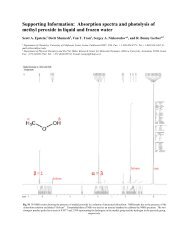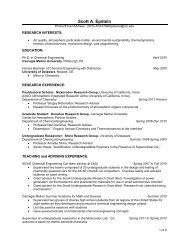Overtone spectroscopy of H2O clusters in the vOH - UCI Aerosol ...
Overtone spectroscopy of H2O clusters in the vOH - UCI Aerosol ...
Overtone spectroscopy of H2O clusters in the vOH - UCI Aerosol ...
- No tags were found...
Create successful ePaper yourself
Turn your PDF publications into a flip-book with our unique Google optimized e-Paper software.
194316-6 Nizkorodov et al. J. Chem. Phys. 122, 194316 2005o<strong>the</strong>r <strong>in</strong> far-<strong>in</strong>frared spectra <strong>of</strong> acceptor-wag vibration <strong>in</strong>H 2 O 2 and D 2 O 2 . 13,49 In practice, <strong>the</strong> A + 1 and B + 1 subbandsfrom K=0 lower are weak because <strong>of</strong> low statistical weightsFig. 2. The E subbands from K=1 lower and K=0 upper arealso weak because <strong>the</strong>se levels can relax all <strong>the</strong> way down toK=0 lower under supersonic jet conditions. F<strong>in</strong>ally, based onv OH =1 fundamental transitions <strong>in</strong> H 2 O 2 , 10 <strong>the</strong> K=1←1bands are likely to be significantly broadened by predissociation.Therefore, <strong>the</strong> dom<strong>in</strong>ant a-type contributions to <strong>the</strong> rotationalstructure should come from i K=0←0 upper A − 2 andB − 2 and ii K=0←0 lower E + subbands.The K=0 upper states <strong>in</strong> <strong>the</strong> vibrationless H 2 O 2 are wellunderstood: <strong>the</strong> donor-acceptor <strong>in</strong>terchange splitt<strong>in</strong>g betweenK=0 upper A − 2 and B − 2 states is 0.65 cm −1 . 13,16,50 Althoughthis splitt<strong>in</strong>g is known to <strong>in</strong>crease for some <strong>in</strong>termolecularmodes <strong>of</strong> H 2 O 2 that encourage <strong>the</strong> donor-acceptor<strong>in</strong>terchange, 13 excitation <strong>of</strong> <strong>the</strong> OH-stretch<strong>in</strong>g states is expectedto reduce it significantly. For example, <strong>the</strong> <strong>in</strong>terchangeA − 2 /B − 2 splitt<strong>in</strong>g is just 0.061 cm −1 <strong>in</strong> <strong>the</strong> 01 − a K=0 lower state. 10 S<strong>in</strong>ce H 2 O 2 reta<strong>in</strong>s its plane <strong>of</strong> symmetry <strong>in</strong>both 1 f 1 b and 02 + a states, <strong>the</strong> orig<strong>in</strong> difference <strong>of</strong> <strong>the</strong> K=0←0 upper A − 2 and B − 2 subbands should equal <strong>the</strong> sum <strong>of</strong> <strong>the</strong>K=0 A − 2 /B − 2 <strong>in</strong>terchange splitt<strong>in</strong>gs between lower and uppervibrational states, i.e., on <strong>the</strong> order <strong>of</strong> 0.7–0.8 cm −1 . Indeed,at our modest resolution, a0.8 cm −1 −separation <strong>of</strong> <strong>the</strong> A 2and B − 2 subband orig<strong>in</strong>s would nicely, albeit fortuitously, expla<strong>in</strong><strong>the</strong> lack <strong>of</strong> <strong>in</strong>tensity alternation <strong>in</strong> <strong>the</strong> spectrum especiallyevident <strong>in</strong> <strong>the</strong> R-branch region, because <strong>of</strong> cancellationat low J <strong>of</strong> <strong>the</strong> predicted B −−2 J even /J odd =6/3 vs A 2J even /J odd =3/6 nuclear sp<strong>in</strong> statistical ratios.In <strong>the</strong> <strong>in</strong>terest <strong>of</strong> simplicity, <strong>the</strong>refore, we have modeled<strong>the</strong> observed transition pr<strong>of</strong>ile as a comb<strong>in</strong>ation <strong>of</strong> i twoK=0←0 upper A − 2 and B − 2 subbands, separated by 0.8 cm −1and ii one K=0←0 lower E + subband, with <strong>the</strong> relative location<strong>of</strong> <strong>the</strong> K=0←0 lower and K=0←0 upper subbands treatedas an adjustable parameter. Each H 2 O 2 subband is calculatedas a near prolate symmetric top with rotational parameterstaken from Ref. 10, with <strong>the</strong> result shown <strong>in</strong> Fig. 6. Thesimulation is consistent with a 7±3 K rotational temperaturesame as for Ar–H 2 O bands discussed below and readilyreproduces several salient features <strong>of</strong> <strong>the</strong> observed band,namely, i parallel structure, ii absence <strong>of</strong> a band gap, andiii no obvious <strong>in</strong>tensity alternation. However, with <strong>the</strong>present <strong>in</strong>strumental resolution, <strong>the</strong> simulation is not verysensitive to <strong>the</strong> transition band orig<strong>in</strong>s, which thus rema<strong>in</strong>poorly determ<strong>in</strong>ed. Never<strong>the</strong>less, <strong>the</strong> rotational structureclearly confirms <strong>the</strong> carrier <strong>of</strong> <strong>the</strong> observed band to beH 2 O 2 that we can tentatively assign to ei<strong>the</strong>r <strong>the</strong> 1 f 1 b or02 + a overtone vibration.Inspection <strong>of</strong> <strong>the</strong> spectrum <strong>in</strong> Fig. 4 <strong>in</strong>dicates <strong>the</strong> potentialpresence <strong>of</strong> several o<strong>the</strong>r H 2 O n bands, <strong>the</strong> assignment<strong>of</strong> which requires identification or suppression <strong>of</strong> <strong>the</strong> muchstronger Ar–H 2 O transitions. S<strong>in</strong>ce <strong>the</strong> water complexes predissociatemuch faster than <strong>the</strong> laser pulse duration see below,<strong>the</strong> Ar–H 2 O bands can be largely suppressed by record<strong>in</strong>g<strong>the</strong> spectrum us<strong>in</strong>g very small IR pump–UVphotolysis delays. This procedure reveals that <strong>the</strong> bands at7240, 7250, and 7282 cm −1 can be ascribed to H 2 O n complexesthat, based on both <strong>the</strong>oretical predictions and matrixstudies, most likely correspond to 2 f 0 b transitions <strong>in</strong> waterdimer Table I. Specifically, Perchard reported a strong bandat 7236 cm −1 <strong>in</strong> argon matrix 26 and a correspond<strong>in</strong>g band at7220 cm −1 <strong>in</strong> nitrogen matrix, 27 which he assigned to 2 f 0 bovertone <strong>of</strong> <strong>the</strong> proton donor unit as well. His assignmentswere recently corroborated by HCAO calculations. 25 CC-VSCF calculations <strong>of</strong> Chaban and Gerber place this bandhigher <strong>in</strong> frequency but also predict a large transitionstrength for 2 f 0 b . 22 The present gas-phase studies providesome additional <strong>in</strong>formation; <strong>in</strong> particular, <strong>the</strong> 7240 and7250 cm −1 bands appear perpendicular which is consistentwith 2 f 0 b vibrational motion predom<strong>in</strong>antly along <strong>the</strong> caxis. The subband spac<strong>in</strong>gs and rotational contours are consistentwith a 2 f 0 b overtone band assignment, but basedon <strong>the</strong>oretical predictions, it could, <strong>in</strong> pr<strong>in</strong>ciple, arise from<strong>the</strong> acceptor 02 − a band. Fur<strong>the</strong>r <strong>the</strong>oretical efforts <strong>in</strong> thisovertone region would be extremely useful to settle <strong>the</strong>seissues.There has been a lot <strong>of</strong> <strong>in</strong>terest <strong>in</strong> <strong>the</strong> spectroscopicquantification <strong>of</strong> H 2 O 2 <strong>in</strong> <strong>the</strong> atmosphere via its overtonetransitions. 35 In view <strong>of</strong> <strong>the</strong> difficulties associated with precise<strong>the</strong>oretical predictions <strong>of</strong> H 2 O 2 overtone frequenciesand <strong>in</strong>tensities, it is challeng<strong>in</strong>g to assign features observed<strong>in</strong> atmospheric transmission spectra to H 2 O 2 withcerta<strong>in</strong>ty. 26 Present observation <strong>of</strong> a rotationally resolvedovertone <strong>of</strong> H 2 O 2 is an important step towards resolv<strong>in</strong>gthis problem. Although <strong>the</strong> proximity <strong>of</strong> <strong>the</strong> 1 f 1 b band <strong>of</strong>H 2 O 2 to free H 2 O transitions reduces its potential usefulnessfor observational work on H 2 O 2 <strong>in</strong> <strong>the</strong> atmosphere, itis <strong>the</strong> only known rotationally resolved overtone transitionrigorously assigned to H 2 O 2 . High-resolution spectra <strong>of</strong>H 2 O 2 overtones, such as v OH =3, should be even more usefulfor <strong>the</strong> observational studies, and this is where futureefforts <strong>of</strong> spectroscopists study<strong>in</strong>g H 2 O 2 should be directed.D. <strong>Overtone</strong> „v OH =2… spectra <strong>of</strong> Ar–H 2 OThe vibrationally mediated IR spectra <strong>in</strong> Fig. 4 areclearly dom<strong>in</strong>ated by transitions <strong>of</strong> Ar–H 2 O van der Waals<strong>clusters</strong>, to which we now turn our attention. Indeed, a questionworth rais<strong>in</strong>g is why <strong>the</strong> spectra <strong>of</strong> such weakly boundvan der Waals complexes can be so prom<strong>in</strong>ent over <strong>the</strong> muchmore strongly bound H 2 O n species, even though <strong>the</strong> latterare likely present <strong>in</strong> much higher concentrations. The answeralmost certa<strong>in</strong>ly has to do with <strong>the</strong> vibrationally mediatednature <strong>of</strong> <strong>the</strong> action <strong>spectroscopy</strong> that requires <strong>the</strong> IR photonto enhance <strong>the</strong> subsequent 193 nm photodissociation <strong>of</strong> H 2 O,ei<strong>the</strong>r <strong>in</strong> <strong>the</strong> complex or its predissociated fragments. Thisenhancement, <strong>in</strong> turn, depends very sensitively on <strong>the</strong> number<strong>of</strong> quanta <strong>in</strong> OH stretch excitation <strong>in</strong> <strong>the</strong> H 2 O subunit, asbeautifully elucidated by Crim co-workers. 36,44,51 For anatom-polyatom species such as Ar–H 2 O, predissociation at<strong>the</strong> first overtone level occurs on a relatively slow time scale10–100 ns, depend<strong>in</strong>g on <strong>the</strong> specific <strong>in</strong>ternal rotor quantumstate excited that, with 7 ns laser time resolution, readilypermits efficient photolysis <strong>of</strong> H 2 O <strong>in</strong> <strong>the</strong> v OH =2 manifold.Fur<strong>the</strong>rmore, v OH =−1 predissociation <strong>of</strong> <strong>the</strong> weakly boundAr–H 2 O complex D 0 140 cm −1 Ref. 42 most likelyDownloaded 26 May 2005 to 128.200.198.26. Redistribution subject to AIP license or copyright, see http://jcp.aip.org/jcp/copyright.jsp





